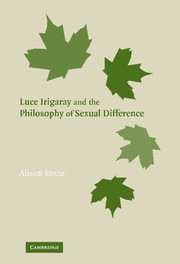Book contents
- Frontmatter
- Contents
- Acknowledgements
- Abbreviations
- Luce Irigaray and the Philosophy of Sexual Difference
- Introduction
- 1 Rereading Irigaray: Realism and Sexual Difference
- 2 Judith Butler's Challenge to Irigaray
- 3 Nature, Sexual Duality, and Bodily Multiplicity
- 4 Irigaray and Hölderlin on the Relation Between Nature and Culture
- 5 Irigaray and Hegel on the Relation Between Family and State
- 6 From Sexual Difference to Self-Differentiating Nature
- Conclusion
- Bibliography
- Index
3 - Nature, Sexual Duality, and Bodily Multiplicity
Published online by Cambridge University Press: 16 November 2009
- Frontmatter
- Contents
- Acknowledgements
- Abbreviations
- Luce Irigaray and the Philosophy of Sexual Difference
- Introduction
- 1 Rereading Irigaray: Realism and Sexual Difference
- 2 Judith Butler's Challenge to Irigaray
- 3 Nature, Sexual Duality, and Bodily Multiplicity
- 4 Irigaray and Hölderlin on the Relation Between Nature and Culture
- 5 Irigaray and Hegel on the Relation Between Family and State
- 6 From Sexual Difference to Self-Differentiating Nature
- Conclusion
- Bibliography
- Index
Summary
Irigaray's philosophy of natural sexual difference is potentially fruitful in promising to revalue nature and bodies by attributing self-expressive agency to them, and in promoting social change to give nature and bodies expression and recognition. But this philosophy is challenged by Butler's theory of gender. According to the revised and strengthened version of this theory which I have proposed, bodies are composed of multiple forces which actively pursue self-enhancement, and which seek political change to encourage this pursuit, in the form of the subversion of gender categories. To decide which approach to embrace, we need, crucially, to ascertain which conception of bodies (if either) is true: Irigaray's conception of natural bodily duality or the competing conception of bodily multiplicity. We need to explore Irigaray's reasons for postulating natural sexual duality and ask what countervailing reasons might support an ontology of bodily multiplicity. This chapter will conclude that some considerations support each ontology, and that we therefore need to develop a theory on which human bodies are naturally both sexed and internally multiple.
In Section I, I examine how Irigaray supports her belief in natural sexual duality with a philosophy according to which nature, as a whole, obeys polar rhythms which find their fullest manifestation in human sexual dimorphism. As Sections II and III explore, this philosophy of nature leads Irigaray to a concomitant rethinking of sexual difference as consisting, ultimately, in a difference between basic rhythms which regulate the development of male and female bodies and forms of experience.
- Type
- Chapter
- Information
- Luce Irigaray and the Philosophy of Sexual Difference , pp. 87 - 126Publisher: Cambridge University PressPrint publication year: 2006



